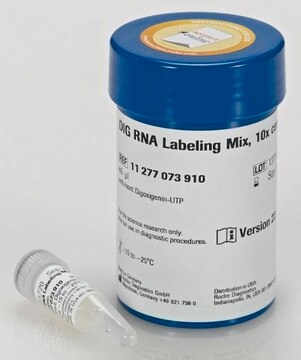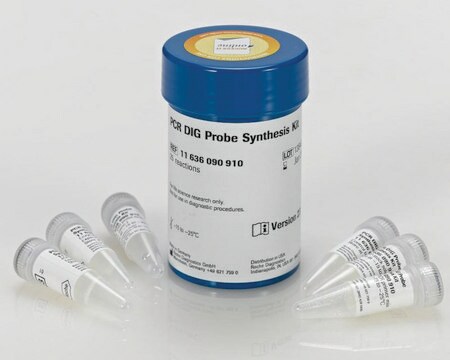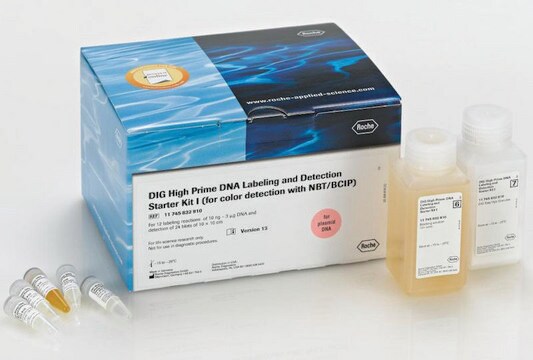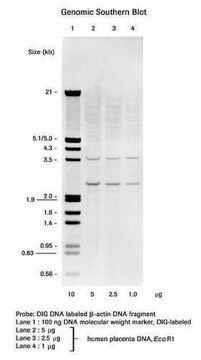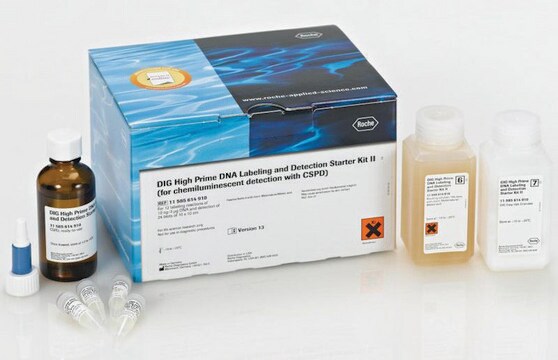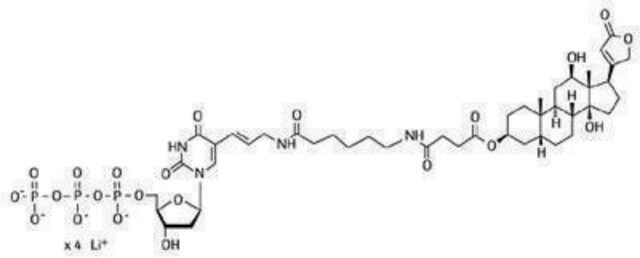11277065910
Roche
DIG DNA Labeling Mix
Sinónimos:
DNA labeling
About This Item
Productos recomendados
form
solution
Quality Level
usage
sufficient for 25 standard reactions
packaging
pkg of 50 μL
manufacturer/tradename
Roche
greener alternative product characteristics
Designing Safer Chemicals
Learn more about the Principles of Green Chemistry.
sustainability
Greener Alternative Product
color
colorless
solubility
water: miscible
greener alternative category
storage temp.
−20°C
General description
We are committed to bringing you Greener Alternative Products, which adhere to one or more of The 12 Principles of Greener Chemistry. This product is designed as a safer chemical. The DIG System was established as a sensitive and cost-effective alternative to radioactivity for the labeling and detection of nucleic acids. There are many available publications that prove the versatility of the DIG System, so use of radio-labeling is no longer the only option for labeling of DNA for hybridization.
Application
- Southern blots
- northern blots
- dot blots
- screening of gene libraries
- in situ hybridizations
Features and Benefits
10x concentrated dNTP labeling mixture: 1mM dATP, 1mM dCTP, 1mM dGTP, 0.65mM dTTP, 0.35mM DIG-dUTP, alkali-labile, pH 7.5 (+20°C)
Assay Time: Labeling: 1 hour to O/N
Labeling efficiency: With 1μg DNA per assay, approx. 10% of the nucleotides are incorporated into about 250ng of newly synthesized labeled DNA within 1 hour and approx. 30% of the nucleotides into about 750ng after 20 hours.
Quality
Principle
Preparation Note
As template for the labeling reaction
- DNA fragments of at least 100bp
- Linearized plasmids, cosmid or λDNA,
- Supercoiled DNA,
- Or minimal amounts of DNA (10ng), e.g., DNA restriction fragments isolated from low melting point agarose can be used.
Note: Linear DNA is labeled more efficiently than circular and supercoiled DNA.
Other Notes
Storage Class
12 - Non Combustible Liquids
wgk_germany
nwg
flash_point_f
No data available
flash_point_c
No data available
Certificados de análisis (COA)
Busque Certificados de análisis (COA) introduciendo el número de lote del producto. Los números de lote se encuentran en la etiqueta del producto después de las palabras «Lot» o «Batch»
¿Ya tiene este producto?
Encuentre la documentación para los productos que ha comprado recientemente en la Biblioteca de documentos.
Los clientes también vieron
Artículos
Digoxigenin (DIG) labeling methods and kits for DNA and RNA DIG probes, random primed DNA labeling, nick translation labeling, 5’ and 3’ oligonucleotide end-labeling.
Nuestro equipo de científicos tiene experiencia en todas las áreas de investigación: Ciencias de la vida, Ciencia de los materiales, Síntesis química, Cromatografía, Analítica y muchas otras.
Póngase en contacto con el Servicio técnico

